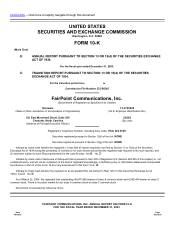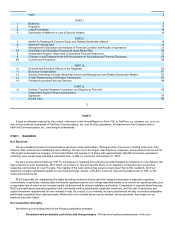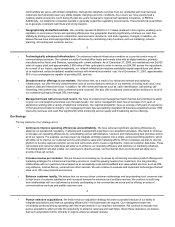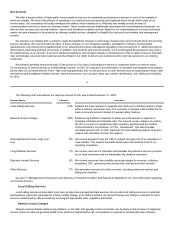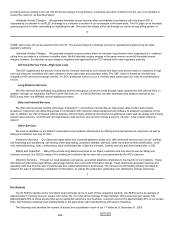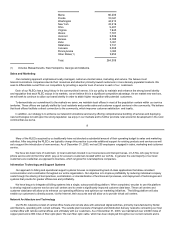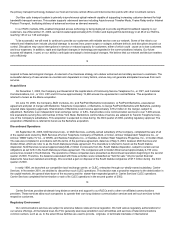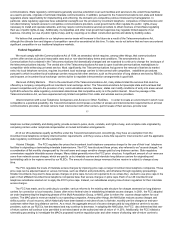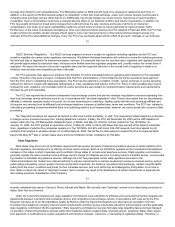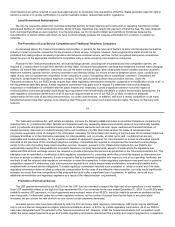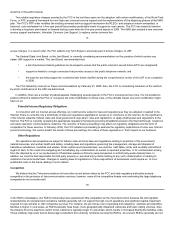FairPoint Communications 2003 Annual Report Download - page 6
Download and view the complete annual report
Please find page 6 of the 2003 FairPoint Communications annual report below. You can navigate through the pages in the report by either clicking on the pages listed below, or by using the keyword search tool below to find specific information within the annual report.
Maine 66,206
Florida 53,041
Washington 44,613
New York 43,219
Ohio 9,487
Virginia 7,945
Illinois 7,787
Vermont 6,599
Kansas 6,008
Idaho 5,951
Oklahoma 3,731
Colorado 3,068
Pennsylvania 3,000
Other States(1) 3,653
Total: 264,308
(1) Includes Massachusetts, New Hampshire, Georgia and Alabama.
Our marketing approach emphasizes locally-managed, customer-oriented sales, marketing and service. We believe most
telecommunications companies devote their resources and attention primarily toward customers in more densely populated markets. We
seek to differentiate ourself from our competitors by providing a superior level of service to each of our customers.
Each of our RLECs has a long history in the communities it serves. It is our policy to maintain and enhance the strong brand identity
and reputation that each RLEC enjoys in its markets, as we believe this is a significant competitive advantage. As we market new services,
we will seek to continue to utilize our brand identity in order to attain higher recognition with potential customers.
To demonstrate our commitment to the markets we serve, we maintain local offices in most of the population centers within our service
territories. These offices are typically staffed by local residents and provide sales and customer support services in the community. We believe
that local offices facilitate a direct connection to the community, which improves customer satisfaction and loyalty.
In addition, our strategy is to enhance our telecommunications services by offering comprehensive bundling of services and deploying
new technologies to build upon the strong reputation we enjoy in our markets and to further promote rural economic development in the rural
communities we serve.
8
Many of the RLECs acquired by us traditionally have not devoted a substantial amount of their operating budget to sales and marketing
activities. After acquiring the RLECs, we typically change this practice to provide additional support for existing products and services as well
as to support the introduction of new services. As of December 31, 2003, we had 235 employees engaged in sales, marketing and customer
service.
We have two basic tiers of customers: (i) local customers located in our local access and transport areas, or LATAs, who pay for local
phone service and (ii) the IXCs which pay us for access to customers located within our LATAs. In general, the vast majority of our local
customers are residential, as opposed to business, which is typical for rural telephone companies.
Our approach to billing and operational support systems focuses on implementing best-of-class applications that allow consistent
communication and coordination throughout our entire organization. Our objective is to improve profitability by reducing individual company
costs through the sharing of best practices, centralization or standardization of functions and processes, and deployment of technologies and
systems that provide for greater efficiencies and profitability.
We have begun to integrate all billing systems into a single, outsourced billing platform. When completed, we plan to use this platform
to develop regional customer service and call centers and to create a significantly improved customer data base. These call centers and
customer data base will allow us to enhance our operating efficiency and optimize our marketing initiatives. The billing platform will also
enable our customers to directly access, via the Internet, their accounts and will allow us to provide virtual call centers.
Our RLEC networks consist of central office hosts and remote sites with advanced digital switches, primarily manufactured by Nortel
and Siemens, operating with current software. The outside plant consists of transport and distribution delivery networks connecting our host
central office with remote central offices and ultimately with our customers. As of December 31, 2003, we maintained over 24,000 miles of
copper plant and 2,800 miles of fiber optic plant. We own fiber optic cable, which has been deployed throughout our current network and is

